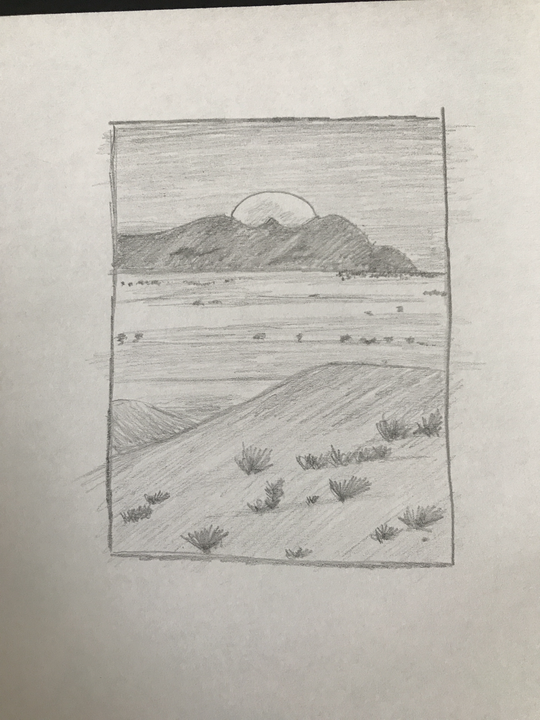Draw a desert landscape
Draw a desert landscape using pencils or markers: sketch dunes, cacti, rocks, and a sun; practice shading, perspective, and color blending.


Step-by-step guide to draw a desert landscape
How to draw Landscape Art for Beginners | Children Scenery Art
Step 1
Find a clean flat spot and place your paper and all your materials in front of you.
Step 2
Lightly draw a horizontal line about one-third up the page to make the horizon.
Step 3
Draw big wavy curved lines across the page to create the shapes of sand dunes.
Step 4
Add short curved ridge lines on the dunes that point toward the horizon to show their shape.
Step 5
Sketch a sun in the sky as a circle or a half circle above the horizon.
Step 6
Lightly sketch several cacti of different sizes to place them at different distances.
Step 7
Draw a few rock shapes near the foreground and middle ground to add interest.
Step 8
Shade the side of each dune and cactus with your pencil to show where the light does not hit.
Step 9
Gently blend the pencil shading with a tissue or cotton swab to make smooth shadows.
Step 10
Use markers or colored pencils to fill the sky sand cacti and rocks with base colors.
Step 11
Layer darker and lighter tones on top of the base colors to blend and make shapes pop.
Step 12
Add final details like cactus spines sand ripples and tiny rock textures with a fine pencil or marker.
Step 13
Sign your name and share a photo of your finished desert landscape on DIY.org
Final steps
You're almost there! Complete all the steps, bring your creation to life, post it, and conquer the challenge!


Help!?
What can we use if we don't have a tissue or cotton swab for blending the pencil shading?
If you don't have a tissue or cotton swab for blending, gently smudge the pencil shading (from the 'Gently blend the pencil shading with a tissue or cotton swab' step) with a clean fingertip or a cotton ball instead.
My dune lines look too dark or messy after sketching—how can I fix that?
If your horizon or dune lines become too dark after the 'Lightly draw a horizontal line' and 'Draw big wavy curved lines' steps, lift excess graphite with a kneaded eraser and redraw more lightly or practice the curves on scrap paper before marking the final sheet.
How can I adapt this activity for different ages?
For younger children, pre-draw the horizon and large dune and cactus shapes and let them color with crayons, while older kids can follow the full steps—adding layered darker and lighter tones, blended shadows with a tissue, and fine-pencil cactus spines—to create more realistic depth.
What are some ways to extend or personalize the desert landscape once it's finished?
To enhance and personalize the finished desert, sprinkle craft sand glued along the lower dunes for texture, add tiny painted clay footprints or a paper cutout lizard near the rocks, then sign and share a photo on DIY.org as the final step.
Watch videos on how to draw a desert landscape
How To Paint A Beautiful Landscape (for kids)
Facts about landscape drawing
🖍️ Artists often layer many pencil strokes or marker passes (sometimes 10+) to create smooth color blends.
🌍 Deserts cover about one-third of Earth's land surface — and some deserts, like Antarctica, are cold!
🌵 Many cacti store large amounts of water in their stems so they can survive long dry seasons.
🏜️ Sand dunes can slowly 'walk' or migrate over time as wind moves sand grains, sometimes meters per year.
🎨 Shading tricks—like imagining a single light source—make flat drawings look three-dimensional.
How do I draw a desert landscape with pencils or markers?
What materials do I need to draw a desert landscape?
What ages is this desert drawing activity suitable for?
What are the benefits and variations of drawing a desert landscape?


One subscription, many ways to play and learn.
Only $6.99 after trial. No credit card required



